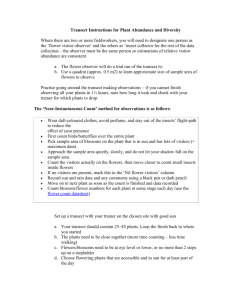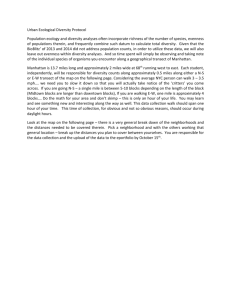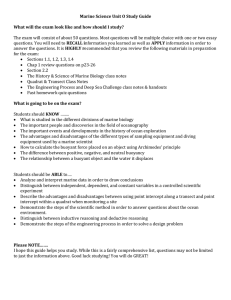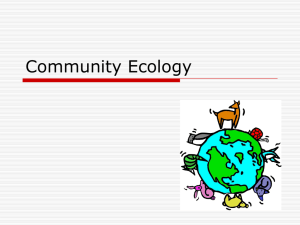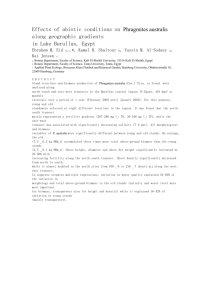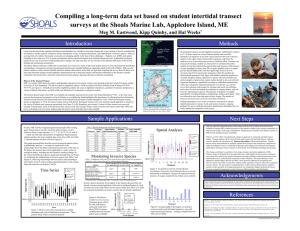Environmental drivers of the fine-scale distribution of a gelatinous zooplankton community
advertisement
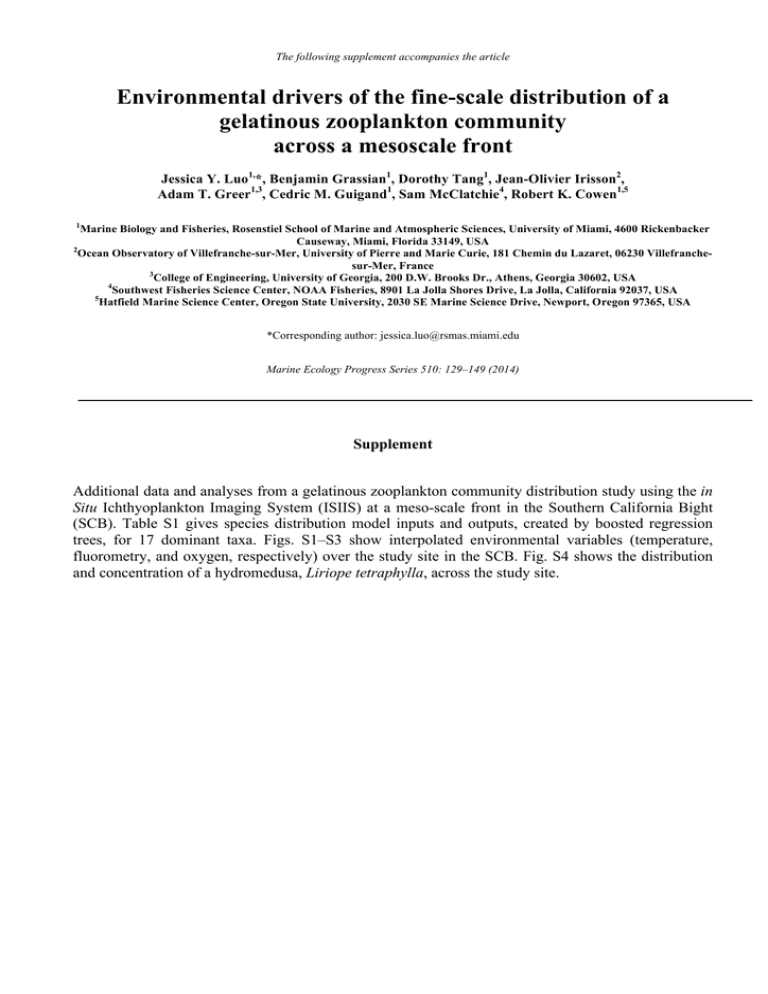
The following supplement accompanies the article Environmental drivers of the fine-scale distribution of a gelatinous zooplankton community across a mesoscale front Jessica Y. Luo1,*, Benjamin Grassian1, Dorothy Tang1, Jean-Olivier Irisson2, Adam T. Greer1,3, Cedric M. Guigand1, Sam McClatchie4, Robert K. Cowen1,5 1 Marine Biology and Fisheries, Rosenstiel School of Marine and Atmospheric Sciences, University of Miami, 4600 Rickenbacker Causeway, Miami, Florida 33149, USA 2 Ocean Observatory of Villefranche-sur-Mer, University of Pierre and Marie Curie, 181 Chemin du Lazaret, 06230 Villefranchesur-Mer, France 3 College of Engineering, University of Georgia, 200 D.W. Brooks Dr., Athens, Georgia 30602, USA 4 Southwest Fisheries Science Center, NOAA Fisheries, 8901 La Jolla Shores Drive, La Jolla, California 92037, USA 5 Hatfield Marine Science Center, Oregon State University, 2030 SE Marine Science Drive, Newport, Oregon 97365, USA *Corresponding author: jessica.luo@rsmas.miami.edu Marine Ecology Progress Series 510: 129–149 (2014) Supplement Additional data and analyses from a gelatinous zooplankton community distribution study using the in Situ Ichthyoplankton Imaging System (ISIIS) at a meso-scale front in the Southern California Bight (SCB). Table S1 gives species distribution model inputs and outputs, created by boosted regression trees, for 17 dominant taxa. Figs. S1–S3 show interpolated environmental variables (temperature, fluorometry, and oxygen, respectively) over the study site in the SCB. Fig. S4 shows the distribution and concentration of a hydromedusa, Liriope tetraphylla, across the study site. Table S1. Boosted regression tree (BRT) model inputs and outputs for all 17 taxa modeled. Columns show the shrinkage rate (also referred to as learning rate), the total number of trees used in the best model, the pseudo-R2 values, and the relative influence of each explanatory variable. The variable with the highest relative influence for each model is in bold Relative influence of explanatory variables (%) Shrinkage rate # trees Pegantha sp. 0.001 Appendicularians R2 Depth Temp. Oxygen Chl a Salinity Front 6131 0.39 14.14 26.92 4.92 26.62 17.95 9.46 0.005 7512 0.57 45.29 24.33 9.07 11.54 8.9 0.87 0.0075 9976 0.74 23.39 30.3 8.46 16.59 11.23 10.03 0.05 8777 0.93 22.52 28.55 11.11 15.07 10.35 12.4 Very small hydromedusae (vsh) 0.015 9864 0.91 30.49 29.67 8.64 13.2 11.58 6.41 Solmundella bitentaculata 0.003 9020 0.53 14.95 30.1 11.41 18.5 14.76 10.29 0.03 7993 0.78 22.32 21.88 12.22 20.78 16.64 6.16 0.0075 7344 0.77 11.85 14.07 25.7 34.98 9.64 3.75 Hormiphora californiensis 0.001 6015 0.13 18.23 26.91 11.55 27.85 10.1 5.36 Agalma elegans 0.003 4425 0.25 12.34 11.47 26.26 30.89 11.16 7.88 Muggiaea atlantica 0.003 8298 0.48 10.48 13.45 19.09 36.85 18.26 1.88 Nanomia bijuga 0.005 8624 0.37 14.72 13.46 28.46 23.57 17.3 2.48 Sphaeronectes sp. 0.005 4651 0.46 18.87 29.22 28.9 9.01 5.78 8.21 Beroida 0.001 9996 0.17 18.57 23.15 20.7 14.38 17.34 5.86 Ocyropsis maculata 0.001 9996 0.22 22.45 17.28 48.17 1.79 6.94 3.36 Diphyidae 0.002 5300 0.16 15.89 21.11 25.39 8.77 27.07 1.77 Solmaris sp.2 0.001 4637 0.14 50.29 19.52 12.01 3.33 7.9 6.95 Taxon h15 Solmaris rhodoloma Liriope tetraphylla Doliolids 2 Fig. S1. Interpolated temperature (°C) profile of the sampled transects in the Southern California Bight (SCB). Distance (in km) is measured along each transect. Top: Transect 1, middle: Transect 2, lower: Transect 3. Orange arrows indicate location of front Fig. S2. Interpolated fluorometry (V), a measure of chl a fluorescence, profile of the sampled transects in the Southern California Bight (SCB). Distance (in km) is measured along each transect. Top: Transect 1, middle: Transect 2, lower: Transect 3. Orange arrows indicate location of front 3 Fig. S3. Interpolated dissolved oxygen (ml l-1) profile of the sampled transects in the Southern California Bight (SCB). Distance (in km) is measured along each transect. Top: Transect 1, middle: Transect 2, lower: Transect 3. Orange arrows indicate location of front Liriope tetraphylla 0 50 1 100 Temp (C) 16 14 12 50 2 Depth (m) 0 10 100 Density 25 50 0 75 50 3 100 0 25 50 75 Distance (km) Fig. S4. Densities of the hydromedusae Liriope tetraphylla plotted on temperature (°C) profile, by transect (top: Transect 1, middle: Transect 2, lower: Transect 3) in the Southern California Bight (SCB). Size of bubble indicates concentration of organisms found in a 1 m depth bin. Orange arrow indicates location of the front. Bars above each panel indicate daylight (white), twilight (gradient) and nighttime (black). Distance (in km) is measured along each transect 4
